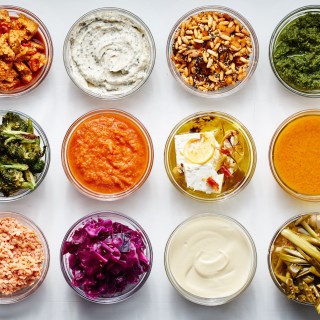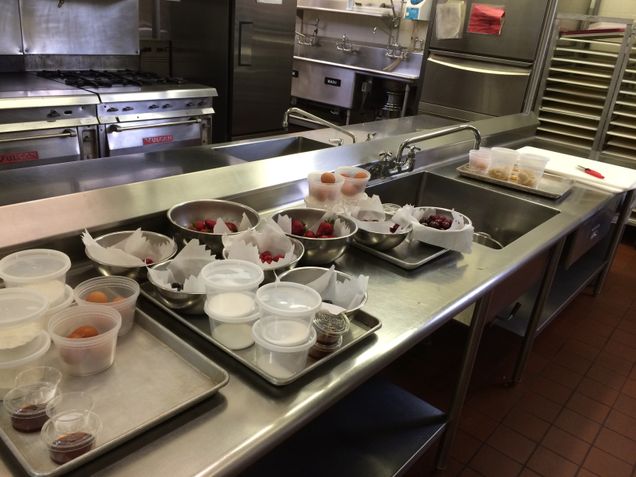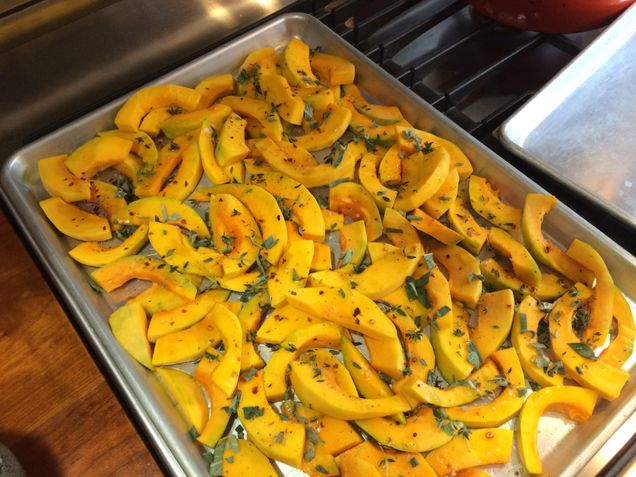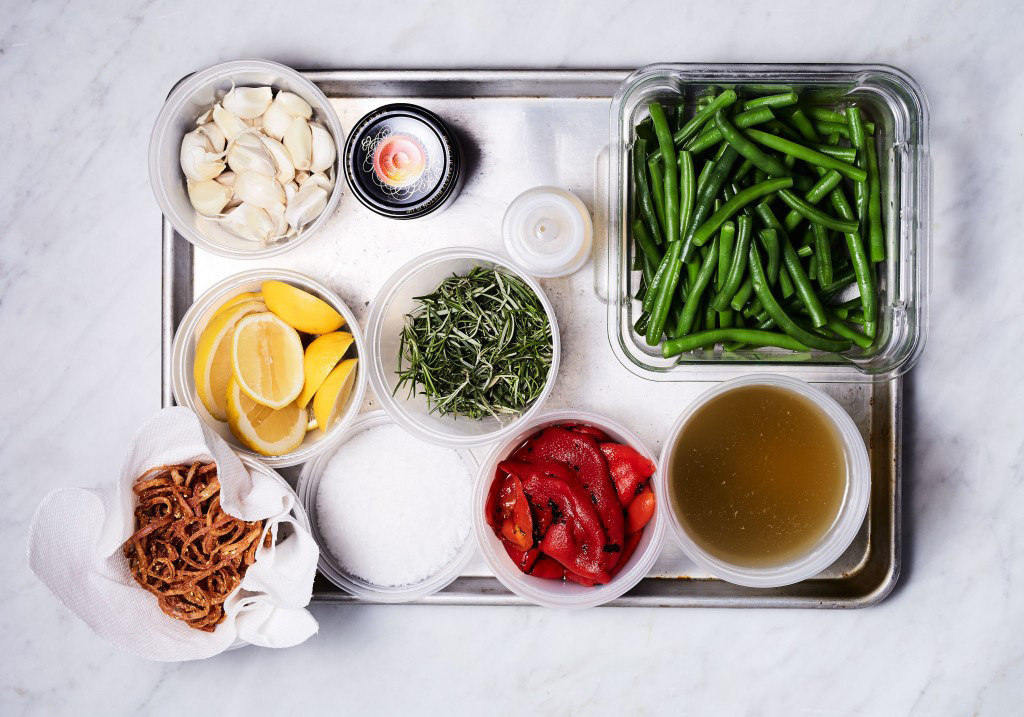CHEF SERIES – Get Meezed
Jessica Spier, Graduate Nutrition Student, SAR ’17
Of the many lessons, tips, and tricks that culinary students and professionals accumulate in their time in a fast paced, high volume kitchen, one in particular stands out most—mise en place. It means, roughly, “everything in place,” standing for the act of preparation required of every chef to make a recipe, meal, or dinner service transition from kitchen to table most seamlessly. The true definition is a concept, an action, the performance of preparing for the next step of cooking. But we use the phrase so often in all manner of grammatical iterations and trans-language amalgamations…

As a verb:
To mise. Also spelled/pronounced to meez.
Implied definition: to gather, measure, cut, and otherwise prepare ingredients for cooking.
Example of use: “We need to mise out this recipe for the risotto tonight.”
As a noun:
The mise.
Implied definition: The prepared and assembled ingredients needed for the recipe or dish being prepared.
Example of use: “Is your mise ready for the next course?”
As an adjective:
Mised
Implied definition: Ready and waiting.
Example of Use: “The seafood stew is mised.” Or “Are you mised and ready to go?”
To really drive home the importance of this concept and culinary mantra, here are celebrity chef Anthony Bourdain’s thoughts on the topic: “Mise en place is the religion of all good line cooks,” he writes in his memoir, Kitchen Confidential. “As a cook, your station, and its condition, its state of readiness, is an extension of your nervous system.” Powerful words about the importance of organization from a chef often thought to go against the grain.
From NPR article, For a More ordered Life, Organize Like a Chef, interviewed culinary students report knowing many individuals who have the phrase tattooed on them, so powerful is the concept in the daily grind of rising chefs. For those of us not as diehard to emblazon the phrase on a forearm, we can still embrace and embody the concept in our daily cooking and eating lives.
So, why should mise en place be so important to you? It’s the ability of this simple concept to organize your cooking, and your daily activities for that matter, into a rhythmic and proactive processes rather than a reactive flailing. It’s how you can make the best food choices for yourself each day, and set yourself up for healthy, happy and sustainable diet patterns long-term with less stress.
What’s the secret to healthy and happy eating? This is it: preparation.
It might sound benign, probably even dull, but any chef knows there is no easier way to lose composure than to have left yourself unprepared from the start. “It’s important not to go down early in your shift,” says chef/author Gabrielle Hamilton in her memoir Blood, Bones & Butter. “And there are things that will bring you down early,” she adds, noting both an insufficient amount of pre-chopped vegetables or the overturned quart of pancake batter now seeking equilibrium in the fridge as both equally perilous to executing an efficient brunch service. The point is, again, preparation. There will be bumps in the road; give yourself the best-prepared chance you can.
An article on the Harvard Business Review website sites this concept of mise en place when noting that “when it comes to goals, the more specific you are about what you’re trying to achieve, the better your chances of success.” The Guardian health and wellbeing columnist Oliver Burkeman agrees: “Don’t just make a plan. Doing it in the meticulous, focused spirit of mise en place makes a difference.”

Let’s look a little more closely at this advice about mise en place…
“First,” Burkeman writes, “it’s a systemic way of discovering what items or supplies you’re missing.” True, having your ingredients prepared and assembled means you are monumentally less likely to forget an ingredient. You’re less likely to bake a cake without adding in the baking powder (this results in more of a hockey puck than a pastry) or to find yourself starving in the middle of a hectic school day and desperately searching the closest, costly, convenience store for any food item you can get your hands on. Work up front saves you time, money, and mistakes later on.
“Second, it involves batching similar activities, reducing the delays and distraction of task-switching.” Also true. If a chef is preparing a dinner menu with a soup, a stir-fry, and a braised chicken dish, all of which call for chopped onion, do you think he/she does the cutting for each recipe in turn? Absolutely not. The preparation is done in batches: all recipes are reviewed ahead of time, like ingredients are grouped, and the work of preparation for an array of recipes is done all at once (chopping first all the onion that will be needed for several recipes, then all the tomato, the garlic, the parsley, and so on). The ingredients are then portioned out per recipe and stored awaiting cooking. It’s inefficient for chefs to prepare ingredients recipe by recipe; the same is true for you.
“Third, it turns the whole thing into and exercise in mindfulness and deepening of concentration.” Right again. Imagine the sense of calm and satisfaction associated with knowing that you can prepare home cooked meals, take balanced lunches and snacks to go, and improve your cooking repertoire while saving money previously spent on wasted food impatiently wilting in the crisper drawer or last minute scrambling for take out options. Yes, mise en place is the strategy to give you this kind of empowerment.
Mise en place can help you organize and mobilize the specifics of achieving long-term objectives in everyday action. It’s a way to set yourself up with a tangible means of reaching dietary goals and incorporating them into your day, week, or lifestyle with mise en place regimens that make cooking and planning habits into everyday instinct.
Here are a few tricks for kicking off your mise en place plans…

Divide and conquer.
Grocery shop one day and divide ingredients into single-use portions while unpacking at home. For instance, if you bought a six-pack of chicken breasts, individually wrap them and freeze them; pull one out of the fridge the night before to be ready for cooking by dinner the next day, and without risking spoilage.
Slice and dice. Cut vegetables and other ingredients ahead of time when you have a free moment in your schedule. Chopping up some onion for one evening’s meal? Why not chop a little more, store it in tupperware, and have it ready to go for meals to be made throughout the week?
Portion and pack. At the start of the week, portion out bags of baby carrots, cups of yogurt, or sandwich ingredients to be assembled at the last minute. This exercise makes packing lunch each day quick and seamless work, and the reward is a balanced and delicious meal waiting for you without the, often costly, mid day scramble.
Cook ahead of time. Hearty chicken and vegetable soup, for instance, can be a delicious and nutritious meal for the week, can be made when you have time over the weekend, and can be pre-portioned and kept fresh in the fridge for several days. Just heat when needed. The same applies to stir-fries, casseroles, braises, and the list goes on.
Balance it out. Need help getting a better composed breakfast without losing sleep to prep that first, essential, meal of day? At the start of the week, hard boil several eggs and chop up a few of your favorite fruits. The morning of, you need only stick a slice of your favorite whole-wheat bread in the toaster. You can be noshing on a well-balanced meal by the time the toaster pops.
When it comes time for making a meal at home, or packing lunch on the run, embracing mise en place practices will help you transform meal prep into muscle memory for the long-term.

Jessica Spier is a current graduate student at Boston University, receiving her MS in Nutrition at Sargent College with intent of becoming a Registered Dietitian working in the Boston community. She holds a BA in English and Spanish languages and literatures from Skidmore College, and a food studies certificate from BU’s Gastronomy program. Jessica attended culinary school through Metropolitan College’s Food & Wine program and has staged at several Boston area restaurants. Currently, Jessica works as a chef and culinary instructor for Cooking up Culture, BU’s cooking program for 1st-12th grade kids, where she teaches culinary skills and techniques for balanced, healthy eating through exploration of diverse flavors and cuisines. Jessica completed her practicum at the Sargent Choice Nutrition Center in spring of 2016.
